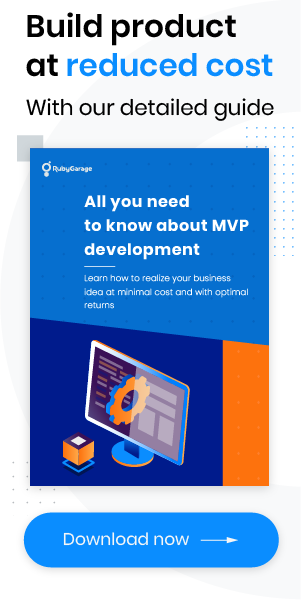-
Product Management
Software Testing
Technology Consulting
-
Multi-Vendor Marketplace
Online StoreCreate an online store with unique design and features at minimal cost using our MarketAge solutionCustom MarketplaceGet a unique, scalable, and cost-effective online marketplace with minimum time to marketTelemedicine SoftwareGet a cost-efficient, HIPAA-compliant telemedicine solution tailored to your facility's requirementsChat AppGet a customizable chat solution to connect users across multiple apps and platformsCustom Booking SystemImprove your business operations and expand to new markets with our appointment booking solutionVideo ConferencingAdjust our video conferencing solution for your business needsFor EnterpriseScale, automate, and improve business processes in your enterprise with our custom software solutionsFor StartupsTurn your startup ideas into viable, value-driven, and commercially successful software solutions -
-
- Case Studies
- Blog
How to Create a Mobile App Startup
The mobile app market is growing and bringing more revenue, but it’s still quite a venture to start a mobile app business. Data from CB Insights shows that only about 30 percent of startups succeed. To ensure the success of your mobile app startup, we’ve prepared some useful tips.
#1 Find a problem to solve
Mobile app startups often concentrate on an idea only, forgetting about crucial factors that lead to its success. But an idea alone might not be enough to hit the market. You should create an app specifically to provide value to your target audience, which you can only do by thoroughly planning the UI/UX and content. During the planning stage, ask yourself the following questions:
What problem does the mobile app startup solve?
If you take a look at the statistics of failed mobile app startups, you’ll see that the majority of them had an idea but didn’t solve a problem. As long as your startup has no aim and no solution to a user’s pain points, it’s not likely to succeed. To stay afloat, you need to offer a solution to a common (and long-lasting) problem.
Does anyone actually want this app?
There’s no point in making an app if there’s no market for it. Even the most outstanding idea will fail if you don’t know your target audience. With more than 5.5 billion apps available in the leading app stores, it seems impossible to create something unique. However, there’s still a chance to achieve success. Define your potential users and predict their needs, what they like, and what they’re afraid of.
Your task is to highlight the use of your app whenever they ask themselves, What do I get out of it? It’s not that easy to make users download your app, let alone like it. To increase the user retention rate, let your users see the benefits of the app right from the start.
#2 Choose the platform
When you have a limited budget and need to check if your idea is going to be profitable, you tend to look for the cheapest way to create an app. However, the price is not the only parameter you should take into consideration. Users’ loyalty to an operating system plays one of the most important roles. While choosing a platform for your app, you’ll inevitably face the Android vs iOS dilemma. Don’t follow your heart; rather, follow the market metrics and potential profit.
Target your users
Looking at the market, it’s obvious that there are more Android users worldwide (around 76 percent of all mobile phone users). This isn’t surprising due to the wide variety of Android smartphone manufacturers. However, when creating a mobile app startup, you should consider the location of your target audience and the local preferences. In the graphic below, you can see the dominant operating systems in different regions. If your target audience is in a region where users are loyal to one operating system, your choice is clear.

If your business model includes paid features, keep in mind that iOS users are more willing to buy apps and make in-app purchases.
Programming languages
Another crucial factor is how hard it is to develop your app, which influences the cost and speed of development as well as the features you can implement.
Android and iOS each support more than one programming language, and you should think of the ability to switch languages if you change the team or technology stack. For instance, iOS apps are developed in Objective-C and Swift, while Android apps use Kotlin and Java. These Android languages work well together, so you can combine them without any halt in development. However, the same is not true with iOS. Carefully choosing between the languages will help you switch between them much faster in the future when you scale and upgrade your app.
Time and cost
The cost of developing a mobile app startup for iOS and Android is approximately the same. The only thing that differs at this point is the testing time. Because of the great number of Android smartphones with different specifications, it takes much longer to check the compatibility of an Android app with devices. Compare 18 iOS devices with relatively the same configurations with hundreds of Android smartphones with a multitude of configurations. It’s a big scope of work for the QA specialist, which leads to increased production costs.
#3 Raise funds
There are various ways to get financing and various funding platforms to choose from. Your task is to weigh the pros and cons to choose the best method of financing. Below, you’ll find top sources of startup funding.
Angel or seed funding
The most preferred option for any startup is an angel investor who’s ready to provide enough capital in exchange for a high rate of return or equity. Angel investors are typically family and friends, prosperous businesspeople, or groups of individuals united by one goal. Seed funding from an angel investor always comes at the start of a promising startup. To put it simply, an investor acquires part of the startup in exchange for money this startup will hopefully make later.
All in all, getting an angel investor is the safest way to get financing for your business in comparison to bank loans and unstable crowdfunding. You don’t have to return the money in case of failure, so there’ll be no debt. Moreover, angel investors are often savvy in terms of conducting business; therefore, they can provide you some guidance.
Common problems with angel investors include lack of involvement (investors are too busy with side projects), the itch for gain (investors expect fast growth), slow funding, reduced founder control, and unclear roles of the founder and angel investor.
You can search for potential investors on AngelList, Funded.com, and Angel Investment Network.
Bootstrapping
Bootstrapping is starting a business without relying on external funding. If you already have some capital to start your small business, you’ll enjoy sole ownership. Unlike with an angel investor, in this case you’re the one with the equity. What’s more, nobody will interfere with your control over the direction of your mobile app startup. No external investor will change the focus of business development.
On the flip side, the CEO bears the personal risk of failing and losing everything invested. Additionally, bootstrapping usually means limited resources, which leads to slow growth.
There are big chances that you can succeed with such an approach, provided you’re focused on your strategy, stick to the budget, and scale carefully.
Bank loans
Taking a loan from a bank may be the first thing that springs to mind when you think about finding funds for your startup. One of the key points is that banks provide some of the lowest interest rates for loans.
However, it’s a challenge to get a bank loan, as you need to provide business credit scores and reports, personal guarantees, collateral, etc. Banks need strong proof that you’re likely to repay them, which is never clear with mobile app startups.
If you’re ready to put in the time and effort to prove that your business is going to bring a healthy cash flow, this option is for you.
Crowdfunding
The most popular funding method among startup CEOs is crowdfunding. There are a number of trusted platforms where one can share their idea and get funding from a big pool of investors. The advantage of this fundraising strategy is that your idea reaches people worldwide. This increases the chances of getting the money you need in a short time. In addition to raising funds, crowdfunding allows you to validate your idea and see if it’s going to be a success.
The most popular crowdfunding platforms are Kickstarter, Indiegogo, and GoFundMe.
#4 Prepare a perfect pitch deck
To attract potential investors, an engaging pitch deck is a must. Your pitch deck must give the essence of your startup, your development plan, and your promotional strategy.
You may have heard of the elevator pitch: it’s your perfect middle ground to strive for. This tactic assumes a short, informative presentation that can describe your product in 30 seconds, which is the length of an average elevator ride. Try to grab attention with the first two sentences, use simple language, don’t complicate your presentation with statistics, and stick to the point.

#5 Build an MVP to test your idea
Building a minimum viable product (MVP) is essential to the success of your startup. An MVP has proved to be the go-to solution for mobile app startups, as it contains only crucial features. Launching an MVP will help you figure out whether your target audience is really interested in your app, allow you to get feedback on possible improvements, and help you validate the concept before you start making a complete app with further iterations. Other benefits you get with an MVP include:
- An affordable core product
- User feedback
- Quick market launch
- Product ready for presentation to possible investors
A lot of top companies launched an MVP before the final app was born. Let’s take a look at the story of Instagram, which became a success in a few months. First, there was an HTML5 prototype called Burbn. Even though the name doesn’t reflect the app idea, Kevin Systrom, the creator, named the app Burbn because he likes whiskey and bourbon. The app featured photo sharing, check-ins, and planned posts. Photo sharing was the most popular component of the app.
After Systrom raised $500,000, Kevin put together a team and focused on developing the photo sharing aspect of the prototype. Having researched the market and their direct competitor, Hipstamatic, they decided to blend photo filters with social elements. So they pivoted to leave only photo editing, posting, liking, and commenting. In eight weeks, there was the Instagram beta.
Thanks to a well-timed pivot and beta testing, Instagram managed to find their unique offer, fix emerging bugs, and launch a unique product. On the launch day, Instagram became the top free photo editing app on the App Store. In ten weeks, there were one million Instagram users. In a year, Facebook bought the company of twelve employees for $1 billion. Even nine years later, we still have a minimalist app with one core feature.
The lesson to learn from this story is that you can launch a successful product in two months if you act fast and make it simple and easy to use.
Among other companies who started with MVPs you can find Uber, Dropbox, Airbnb, Facebook, Spotify, and Pinterest. Thanks to their MVPs, these companies fixed issues with their apps, got fresh ideas, and evolved into the perfect products we now enjoy.
#6 Promotion
After you’ve made an MVP, you need to deliver it to your target audience as soon as possible. There are different channels for advertising and promoting your app. The promotion strategy you choose can have a big influence on your app’s success. Some of the most popular ways to publicize your app are:
Social media marketing
Entrepreneurs use social networks to increase brand awareness and engagement, generate leads, get customer support, etc. There are a lot of social networking sites, so how can you find the perfect match and reach your goals? We’ve chosen the top five social networks:
Facebook is a must for any startup. However, B2C startups are likely to get more from this network. If your startup is a social network, photo or video editing, ecommerce, travel, beauty, or fashion app, pay extra attention to strengthening user engagement and connections. Whatever startup you have, effective interaction with users will add value to your product. For instance, RunKeeper, a fitness app, promotes its brand on Facebook by posting entertaining sports trivia and photos of runners in branded gear.
Instagram is a pure B2C platform that gives unlimited opportunities to startups in the travel, fashion, health, arts, food, ecommerce, beauty, and photography industries. Also, if your target audience is young women or Millennials, Instagram is a must. Moreover, it shares the same ad platform with Facebook. To make your Instagram account more comfortable to use, switch to the business profile, where you’ll find analytics on engagement, likes, audience, etc.
Visit the Instagram page of Intercom, a customer messaging platform, to see how they interact with their followers on a daily basis. Intercom actively uses the Instagram questions feature, posting answers in Stories. According to MediaKix, Instagram stories and posts are the most efficient content promotion tools and will stay the focal point of many advertising strategies.
LinkedIn is an irreplaceable (and the most business-centered) platform for B2B startups. Companies in the finance, employment, legal, IT, science, and technology sectors are more than welcome to use LinkedIn. As it’s business only, B2B promotion looks organic in this environment. A startup that resolves the pain points of businesspeople is sure to reach its target users and generate qualified leads on LinkedIn. According to HubSpot findings, LinkedIn generates the highest conversion rate at 2.74%, three times higher than Twitter and Facebook combined.
Amazon keeps its product news updated and engages followers in conversations by posting photos from science fairs and posting short bios of their outstanding workers. My first 100 days in Amazon posts are especially popular among followers.
YouTube
This is a perfect network for visual content and can greatly contribute to your brand. Another advantage of YouTube is that it has access to the Google Ad platform. YouTube videos are a good way to promote B2B companies and startups that are visually driven. It’s a great choice for ecommerce, as users feel more confident after watching product videos.
YouTube has become a valuable platform for Canva, a free design tool. Canva posts workshops on how to use their product and shows off the amazing results their users achieve.
Communication and information businesses use Twitter to generate content and promote themselves. It’s more of a B2C platform, which is why so many customers refer to Twitter accounts if they have issues with a product. Twitter can be a fast and convenient addition to your customer service. Industries that can benefit from Twitter include retail, ecommerce, travel, and sports.
Chanty, an AI-powered team chat, grew their number of Twitter followers organically. Posting behind-the-scenes tweets, using hashtags, and prompting replies helped Chanty gather an active community around the product.
Influencers
The best advertising is a recommendation based on personal experience from an opinion leader or trendsetter. Research by Twitter shows that nearly 40 percent of users have bought a product because of a recommendation from an influencer. The reason for that is the native type of advertisement influencers offer and the level of trust they already have.
If you’re looking for an influencer, contact:
- Celebrities
- Industry experts
- Popular bloggers
- Micro-influencers
All of these people have reputations and a lot of followers who can become your potential users. Moreover, there’s payment flexibility. Even micro-influencers with 2,000 to 10,000 followers can offer a loyal audience with high engagement.
To resonate with your target audience, choose the right social network. Which is right directly depends on your niche and target audience. We recommend working with influencers on the social platform you already use. Thus, it’s a good idea for B2B startups, such as SaaS and consulting services, to collaborate with LinkedIn industry experts for relevant and valuable leads. Fashion, ecommerce, beauty, and lifestyle startups can attract thousands of users by working with Instagram and YouTube influencers. Messengers and information-driven startups will resonate among the followers of Twitter influencers.
For a successful influencer promotion, follow these tips:
- Address niche influencers in your sphere
- Create unique promotional materials
- Prioritize platforms
- Set clear goals and expectations, e.g. to increase engagement or expand reach
- Add individual hashtags to monitor and measure the success of ad campaigns
- Provide influencers with clear guidelines of how to promote your brand
ASO
App store optimization (ASO) is SEO for applications. ASO makes it easier for users to find your app. With the help of ASO, you can improve your app ranking on the Google Play Store and the App Store. ASO increases app exposure and user engagement. By investing in ASO, you ensure that your app won’t get lost at the bottom of lists.
Pay extra attention to the features below when listing your app startup:
- App name, URL, and subtitle. All these attributes must reflect the idea of your app and include the main keywords that refer to your app.
- Keywords. This is the crucial attribute in terms of optimizing your app in search results. Research keywords in user search queries and fill in this field thoroughly.
- Ratings and reviews. Ratings and reviews are not only a deciding factor for the majority of users but a ranking signal for app stores. The number of reviews, recent votes, and positive ratings matters. Motivate your users to leave regular reviews, and don’t forget to reply to them.
Over to you
Creating a mobile app startup is easy. Creating a successful mobile app startup is a challenge.











